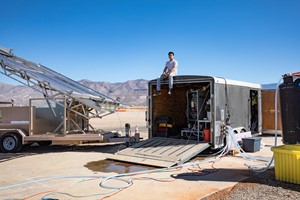Researchers at the Massachusetts Institute of Technology (MIT) have developed an innovative brackish groundwater desalination system powered entirely by photovoltaic (PV) energy. This cutting-edge system uses photovoltaic electrodialysis (PV-ED) technology, enabling direct-drive desalination with high production rates and minimal energy storage requirements. It has successfully operated for six months in New Mexico, producing up to 5,000 liters of water daily and utilizing approximately 94% of the energy generated by its PV modules.
The system is designed to adapt dynamically to fluctuations in solar radiation, maximizing energy generation. According to the research team, “The solar-powered system removes salt from water at a pace that closely follows changes in solar energy.” As sunlight increases, the system enhances its desalting process and adjusts accordingly to sudden changes, such as cloud cover. This responsiveness is crucial for optimizing performance throughout varying weather conditions.
PV-ED technology separates ionic species from brackish water using direct current power to electrically charge membranes, creating an electrical potential difference. This approach boasts advantages over traditional reverse osmosis (RO) methods, including higher water recovery rates, easier operation, and longer membrane lifetimes. However, challenges such as membrane fouling and permselectivity have hindered broader commercial adoption.
The system is composed of solar panels, maximum power point tracking (MPPT), batch tanks, parallel pumps, an electrodialysis stack, and reversal valves. The electrodialysis stack features pairs of cation exchange membranes (CEM) and anion exchange membranes (AEM) that facilitate ion transfer. By controlling the flow rate and current density, the system adjusts its operations to match available power seamlessly.
The team emphasizes that this flow-commanded current control PV-ED strategy holds promise for resource-constrained communities and could play a significant role in decarbonizing energy-intensive desalination industries, making brackish groundwater a valuable source of drinking water for remote populations.














